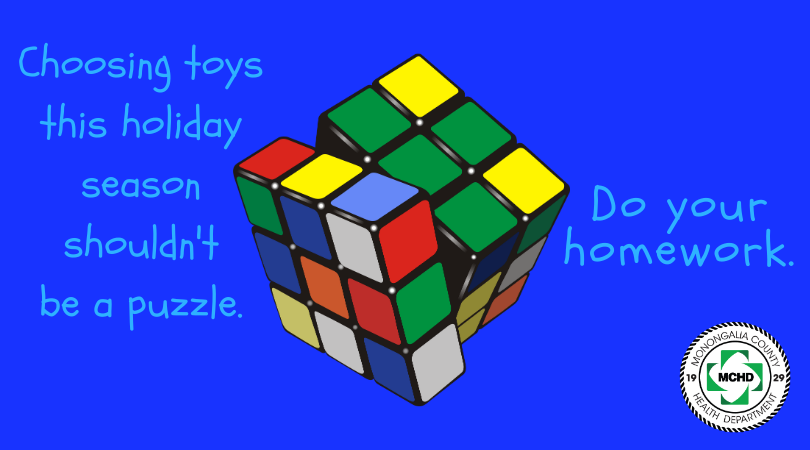Choose age-appropriate toys for your kids this holiday season

Dec. 11, 2019
By Mary Wade Burnside
It’s that time of year again, when fidget spinners, LEGO bricks and mini-drones (yes, mini-drones) might be topping some holiday gift lists for kids.
But toys come with age guidelines, and they are not just suggestions. As with any toy, parents should do some research to make sure it’s age-appropriate for their children.
Monongalia County Health Department’s Environmental Health program wants to make sure parents take some of these facts into consideration as they shop for their kids during the holiday season.
According to the United States Consumer Product Safety Commission, any items with smaller, removable parts should not be in the hands of kids under 3 years of age. Also, all kids should be warned against putting any of the toys’ parts in their mouths.
Kids 3 and under, however, are especially vulnerable because they often put just about any item in their mouths.
According to a variety of sources, between 200,000 and 250,000 children a year visit emergency departments following a toy-related injury. The CPSC placed that number at 226,100 in 2018. Seventy-three percent of those children were under the age of 15; 37 percent were under the age of 5. Most toy-related injuries involve cuts and bruises, often to the head and face.
The highest percentage of those accidents, 19 percent, took place on non-motorized scooters while an additional 5 percent were on toy vehicles. Sometimes these accidents involve a collision with a car; in other instances, young children have drowned after wheeling their toy vehicle into swimming pools.
Of course, any riding toys—bikes, scooters, skateboards, skates—should be accompanied by the appropriate protective gear, which can include helmets and knee and wrist pads.
Another 25 percent of the toys weren’t specified in the CPSC statistics. Toy balls and building sets accounted for another 14 percent of injuries.
The good news is that the number of overall injuries requiring ED treatment has gone down since 2010, from 242,000 to 226,100. But that doesn’t mean parents should become complacent when it comes to the toys their children are playing with.
Another factor to consider is battery-operated toys. Here are some tips on how to handle those items when children are involved:
• Keep button batteries away from small children. Each year, nearly 3,000 children are treated in emergency departments after swallowing button batteries, according to Safe Kids Worldwide (safekids.org).
• Be present when products with batteries are charging.
• Never charge a product with batteries overnight while you are sleeping.
• Unplug the toy immediately once it is fully charged.
• Have working smoke alarms in your house to protect you if there is a fire.
Also, make sure toys such as crayons and markers are labeled “nontoxic.” And be aware that toys that are marked ATSM have met the American Society of Testing and Materials standards.
After making sure a toy is age-appropriate, the next mantra is reminiscent of the one real estate agents use, but instead of “location, location, location,” it’s “supervise, supervise, supervise.” Especially in the beginning, when children are first getting the hang of a new toy.
And perhaps you’ve lectured your children about sharing toys. But depending on the age range of the kids, that’s not always good advice and might prompt a toddler to play with a toy meant for older children.
Everyone wants to have happy holidays. Spending time with your kids as they get accustomed to new toys is a great way to do that and make sure they stay safe.
Mary Wade Burnside is the public information officer at Monongalia County Health Department.